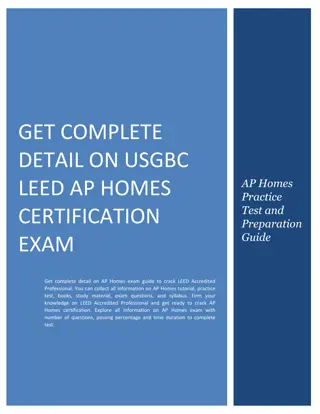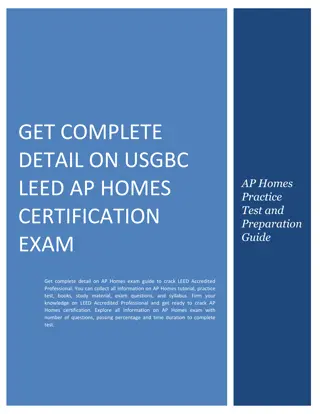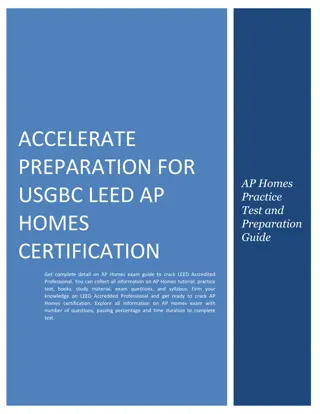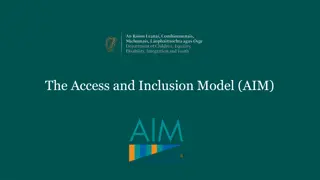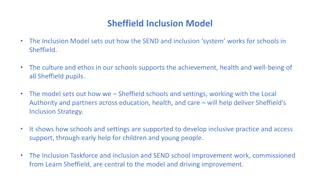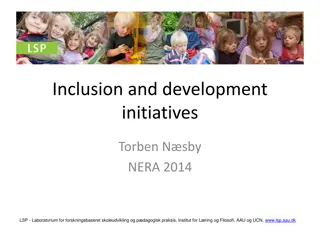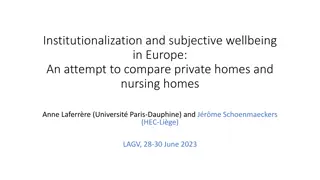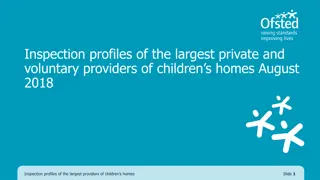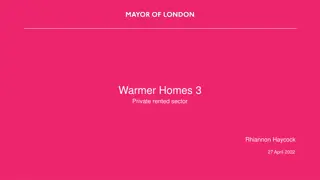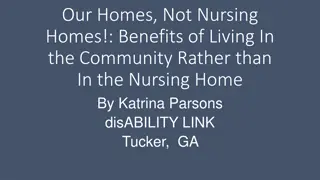Exploring Outcomes of Transitioning from Group Homes to Home Share: Inclusion BC Conference Study
This project, led by Dr. Rachelle Hole and Dr. Tim Stainton, aims to evaluate the experiences of self-advocates transitioning from group homes to home share. The study, initiated and funded by CLBC, focuses on how home sharing influences quality of life. The research design involves a qualitative approach to understand individual satisfaction and the impact on quality of life. The study includes participants from various regions, and interviews are conducted to gather in-depth insights.
Download Presentation

Please find below an Image/Link to download the presentation.
The content on the website is provided AS IS for your information and personal use only. It may not be sold, licensed, or shared on other websites without obtaining consent from the author. Download presentation by click this link. If you encounter any issues during the download, it is possible that the publisher has removed the file from their server.
E N D
Presentation Transcript
Evaluating the outcomes for Evaluating the outcomes for people who have moved from people who have moved from group home to home share group home to home share Inclusion BC Conference May 2015 Vancouver, B.C CENTRE FOR INCLUSION AND CITIZENSHIP
Project Team Dr. Rachelle Hole Associate Professor, School of Social Work UBC Okanagan Co-director, Centre for Inclusion and Citizenship Professor and Director of the School of Social Work UBC Director, Centre for Inclusion and Citizenship Masters Candidate, UBC Okanagan School of Social Work Dr. Tim Stainton Assunta Rosal Jordan Lige Self-Advocate CENTRE FOR INCLUSION AND CITIZENSHIP
Background of the Project Initiated and funded by CLBC Purpose is to explore self advocates experiences of transitioning from group homes to home share with a special focus on how living in home share influences self advocates quality of life (QoL) as informed by Dr. Schalocks QoL index. CENTRE FOR INCLUSION AND CITIZENSHIP
Research Design Exploratory qualitative study Aim to gather in-depth information about the transition from group home living to home sharing: Understanding individual satisfaction with their current home sharing experience Understanding how an individuals quality of life is impacted by the home sharing model Data collection interviews (face to face, Skype and telephone interviews) Data analysis thematic analysis finding patterns and interrelationships in the data (interviews). All names and places have been changed in quotes used in this presentation.
Participants Participants: Central and Northern BC Van. Is./ Sunshine Coast Lower Mainland Participants Interior Total # Number of Self-Advocates represented # of Self Advocates 4 12 1 17 25 # of HS Providers 1 6 7 Number of Self-Advocates we spoke to directly # of Family Members 3 4 1 8 Total Interviews - 32 17
Participants Participants: Age & Gender of Self Advocates Represented in Study Age Male Female 19 30 years 6 31 40 years 12 41 50 years 5 10 15 51 60 years 2 61 70 years 71 years & over 25 Total # of Self Advocates Represented
Quality of Life (QoL) Framework International recognized Schalock QoL model Represents over 30 years of research about QoL From a sensitizing notion of A Good Life to a social construct Provides a conceptual framework to assess personal outcomes Mechanism for operationalizing and measuring UNCRPD rights CENTRE FOR INCLUSION AND CITIZENSHIP
Quality of Life (QoL) Framework Four organizing principles: QoL same factors and relationships for all people; QoL experienced when individual needs are met and person has the opportunity to pursue life enrichments in major life activity settings QoL has both subjective and objective components; and QoL is a multidimensional construct, influenced by Individuals and environmental factors (Verdugo et al., 2012) 1. 2. 3. 4. CENTRE FOR INCLUSION AND CITIZENSHIP
Quality of Life (QoL) Framework 3 Second-order factors and 8 Domains Independence Personal Competence Self-determination Social Participation Interpersonal relationships Social Inclusion Rights Personal Well-being Emotional Physical Material 1. 1. 2. 2. 1. 2. 3. 3. 1. 2. 3. CENTRE FOR INCLUSION AND CITIZENSHIP
INDEPENDANCE: Personal Development 80% of respondents reported improved PD since moving from GH to HS SA are doing more for themselves PD varied widely from simple tasks of daily living to more complex activities such as organizing one s schedule. Participants also described areas where they might still need supports. Ability to travel independently was an example of improved PD CENTRE FOR INCLUSION AND CITIZENSHIP
INDEPENDANCE: Self-Determination Who decides? 1. 2. Increased Autonomy 3. SA s doing more for themselves 4. SA liked HS better because Needs no longer secondary to other residents Increased flexibility. 5. More control over environment 6. Increased Personal controls 7. Sensitivity to preferences 1. 2. CENTRE FOR INCLUSION AND CITIZENSHIP
Transitioning from GH to HS Decreased sense of personal controls when HS presented as the only option 2. Despite this - SA are now in HS they liked better than GH and where they wanted to continue to live. 3. All seventeen SA interviewed stated they preferred HS to GH 4. Participants reported HS supporting SA to achieve unique desires and personal goals. 5. Opportunities to express preferences and choices. 1. CENTRE FOR INCLUSION AND CITIZENSHIP
SOCIAL PARTICIPATION: Interpersonal Relationships Relationships between HS and SA pivotal and significant HS provider often a primary source of emotional, physical and social supports. 2. SA described HS providers in affectionate terms. 3. Many HS providers worked first as a support worker to the SA. 4. Long established friendships 5. HS providers proud of SA accomplishments 1. CENTRE FOR INCLUSION AND CITIZENSHIP
SOCIAL PARTICIPATION: Interpersonal Relationships 1. Intimate relationships 2. Family relationships 3. Social Networks 4. Home share providers and family members collaborating = improved QoL for SA CENTRE FOR INCLUSION AND CITIZENSHIP
SOCIAL PARTICIPATION: Social Inclusion Community integration and participation 4 SA attended church weekly and participated in church activities. 15 SA described participation in Special Olympics, volunteering, arts & crafts, cooking classes and other activities offered through community centre. 10 SA preferred less active social schedule: spending time at home, going for coffee, hanging out. CENTRE FOR INCLUSION AND CITIZENSHIP
SOCIAL PARTICIPATION: Rights 3 SA no longer interface with the legal system. 1. 2. 1 SA lived on the streets, then in GH and finally HS 3. Human rights were raised directly in three interviews 1 SA no longer on probation In adequate Notice that the Group Home was closing In appropriate HS placement led SA to develop anxiety a. b. c. CENTRE FOR INCLUSION AND CITIZENSHIP
PERSONAL WELL BEING: Emotional Contentment Happy Factor 1. 2. Improved Self-concept 3. Lack of Stress 4. Affection CENTRE FOR INCLUSION AND CITIZENSHIP
PERSONAL WELL BEING: Physical Improved Overall Health focus on fitness 1. 2. Management of medications linked to emotional well-being 3. Daily Living self care and mobility 4. Physical Activities recreation 5. Self-care and personal competencies linked to limitations of the individuals disability. CENTRE FOR INCLUSION AND CITIZENSHIP
PERSONAL WELL BEING: Material Financial Status 1. 2. Employment 3. Housing - Home Share Pluralistic relational intervention: addresses individual limitations and societal barriers Responsive to SA unique needs, interests and dreams ( A Good Life), increases social inclusion, normalizes life experience and protects human rights. 1. 2. CENTRE FOR INCLUSION AND CITIZENSHIP
Flexible and Responsive Part of the Family 1. 2. Separate suite 3. Part of the family/separate suite 4. Duplex 5. Roommates vs married couple 6. Jordan s Home CENTRE FOR INCLUSION AND CITIZENSHIP





